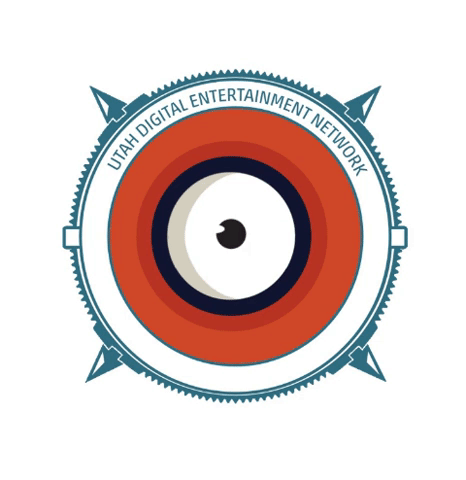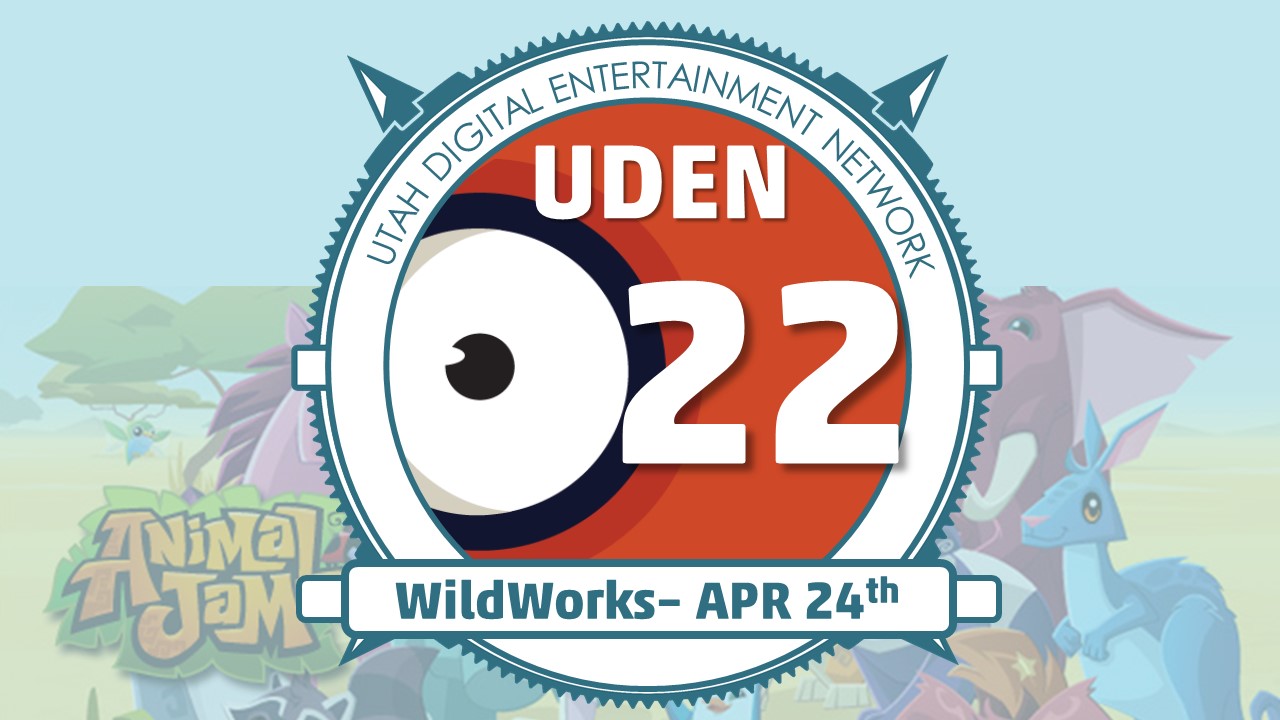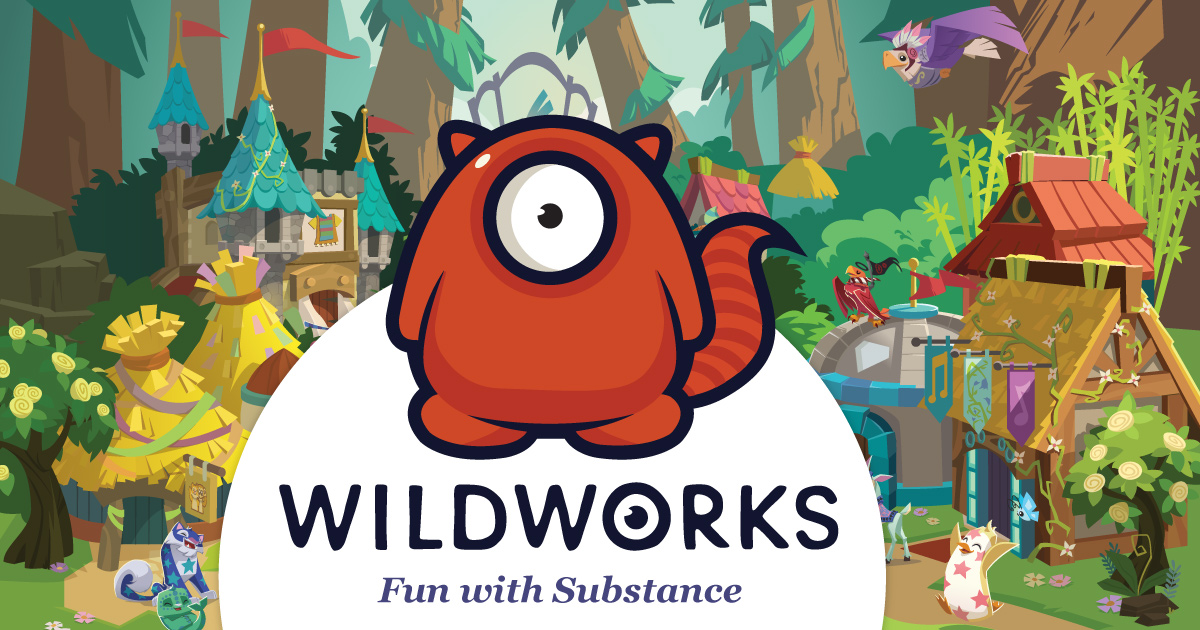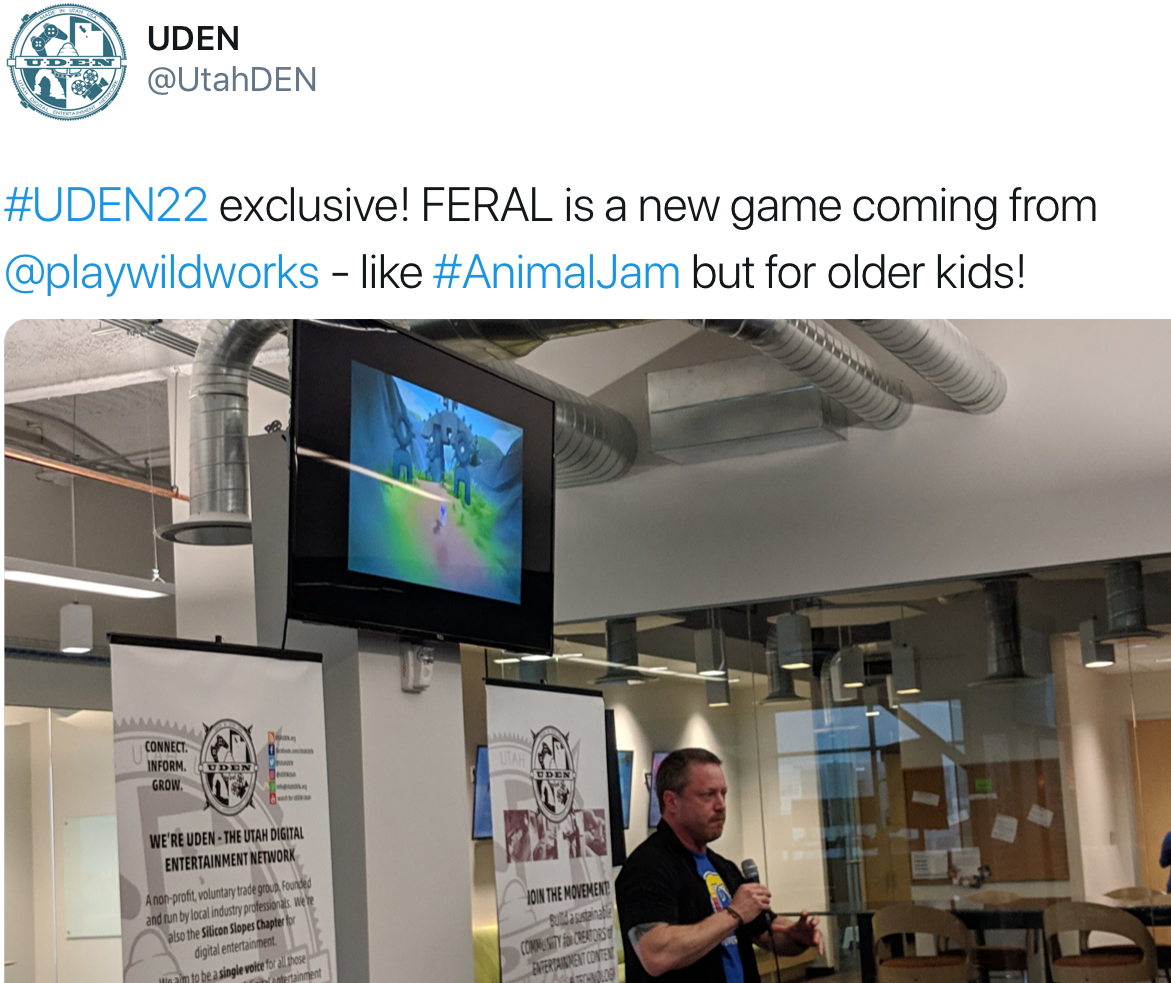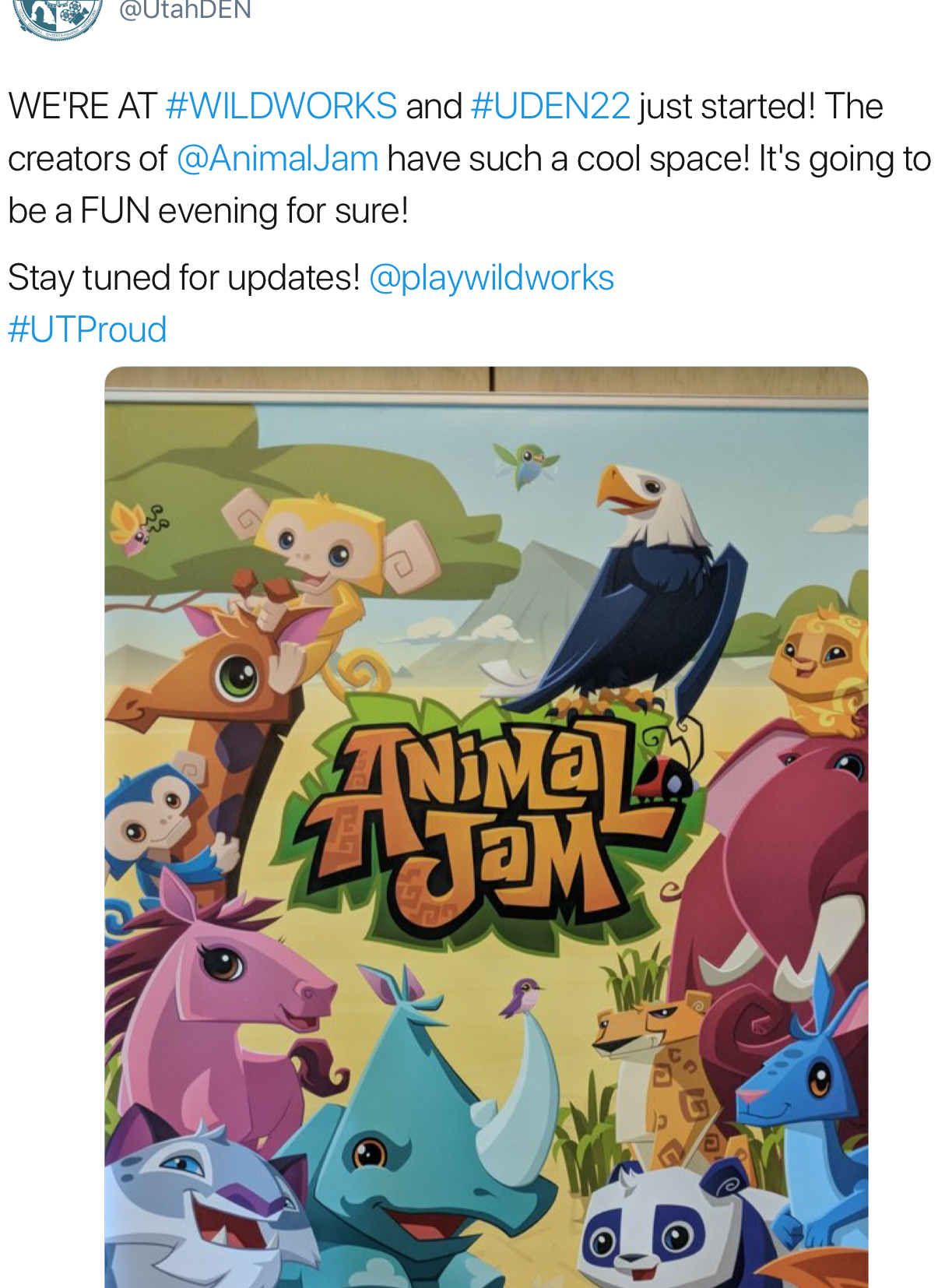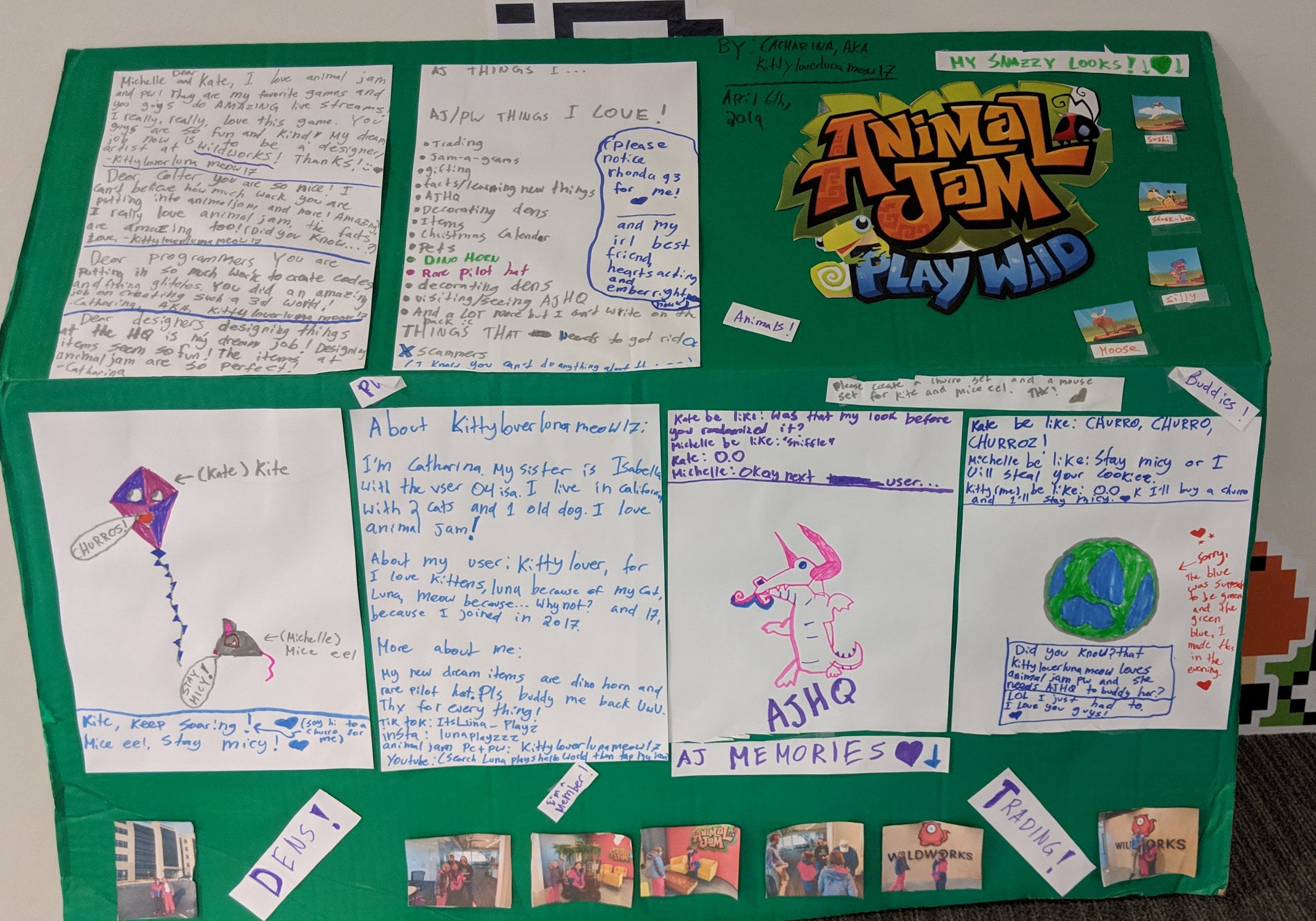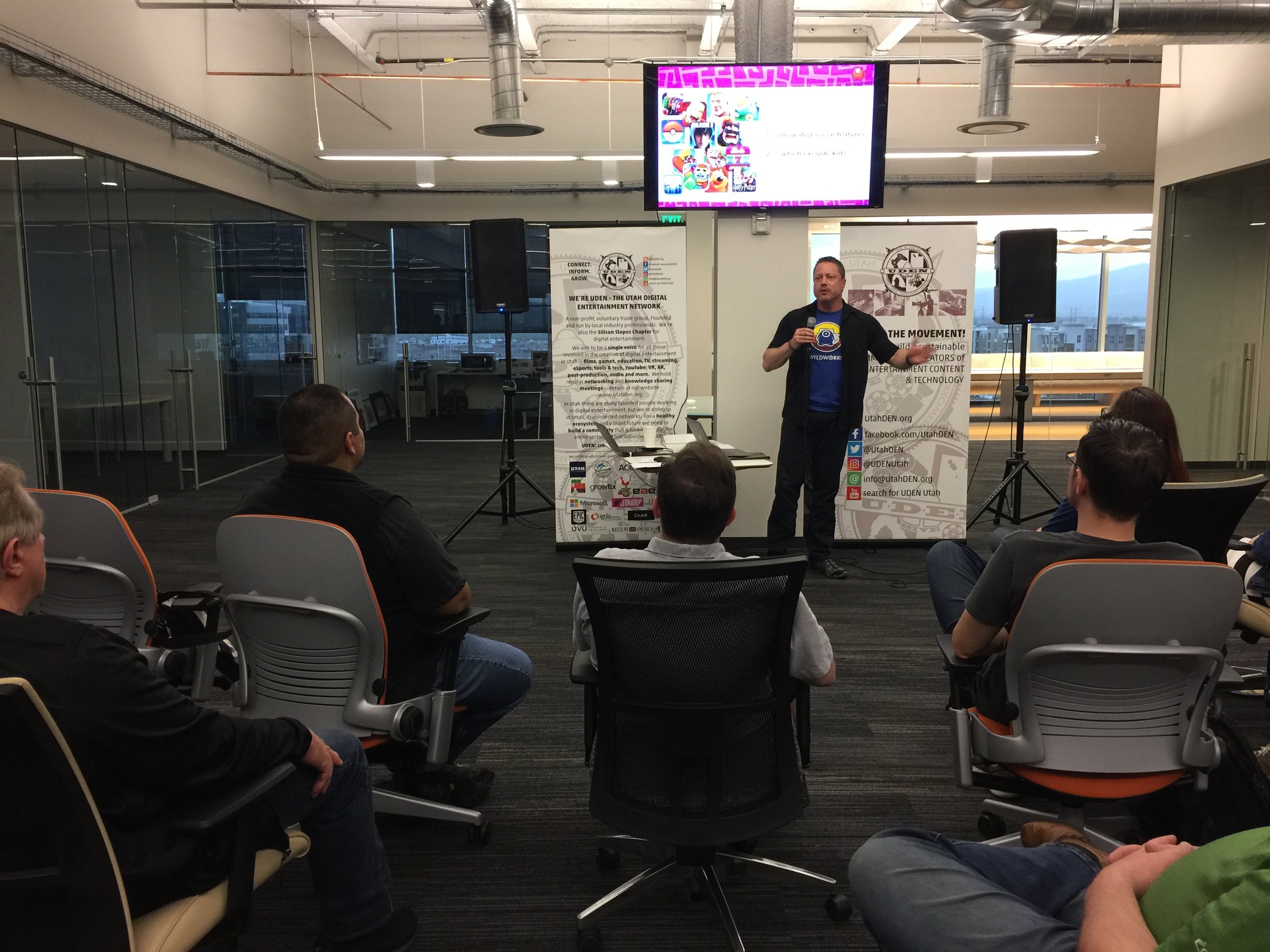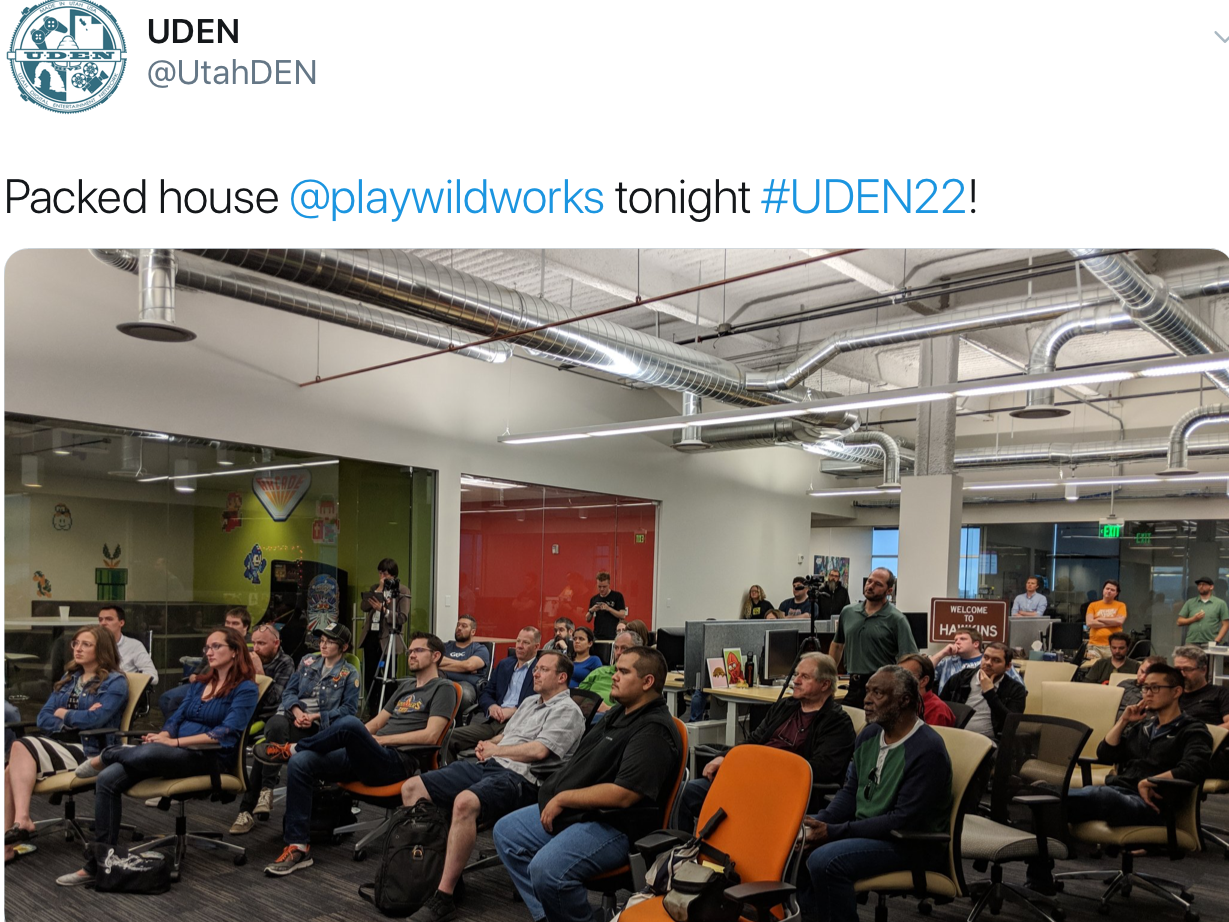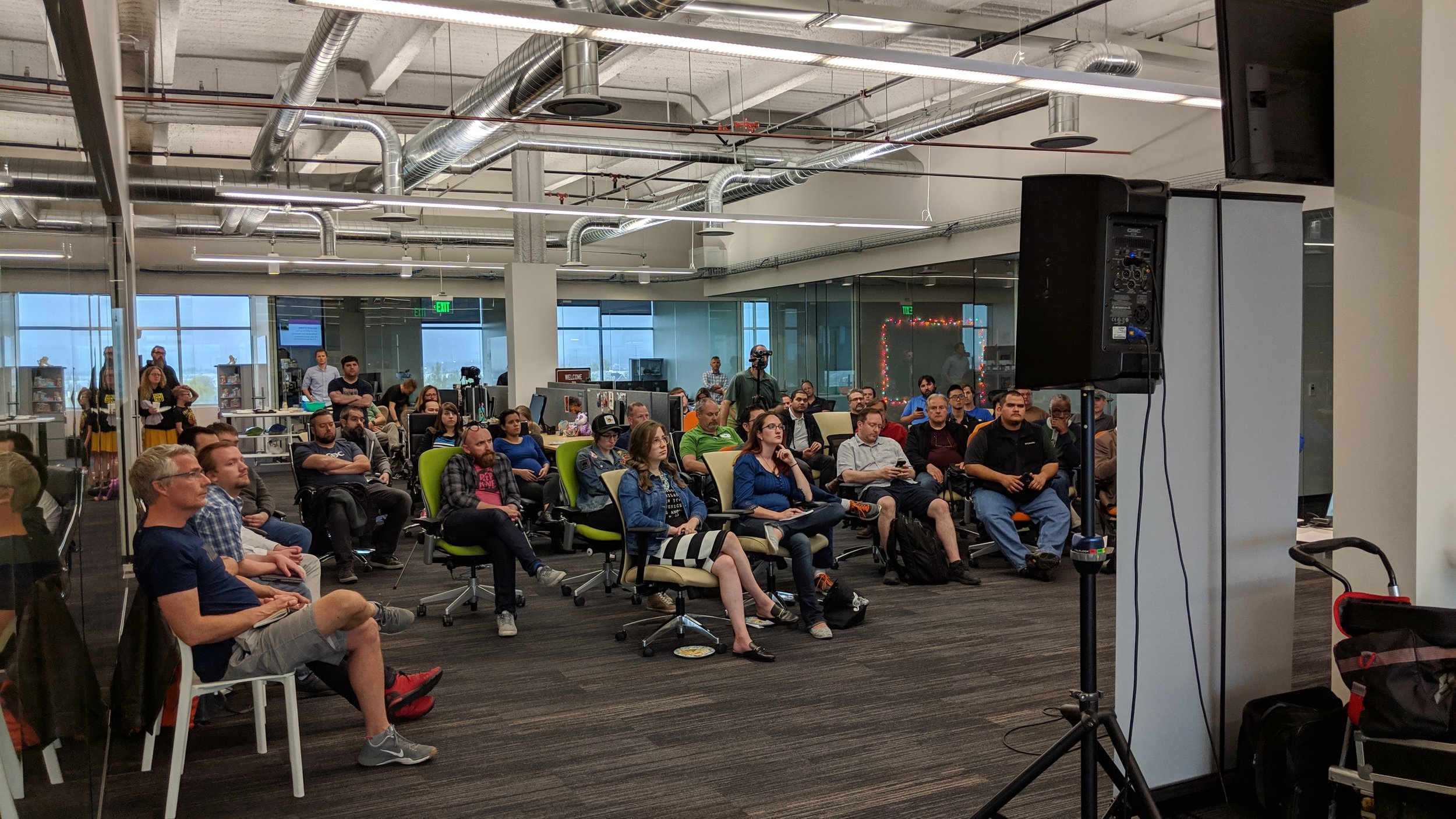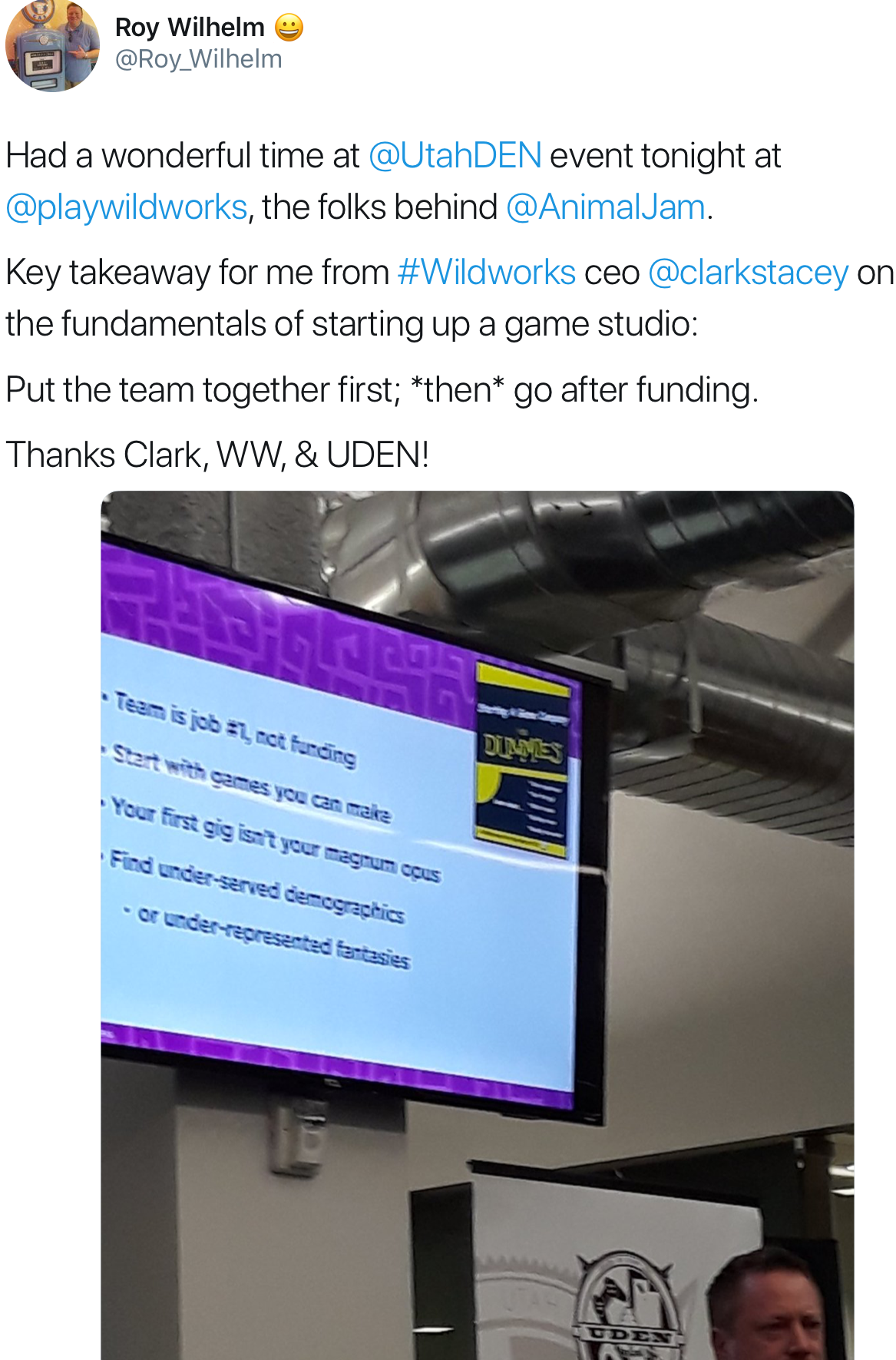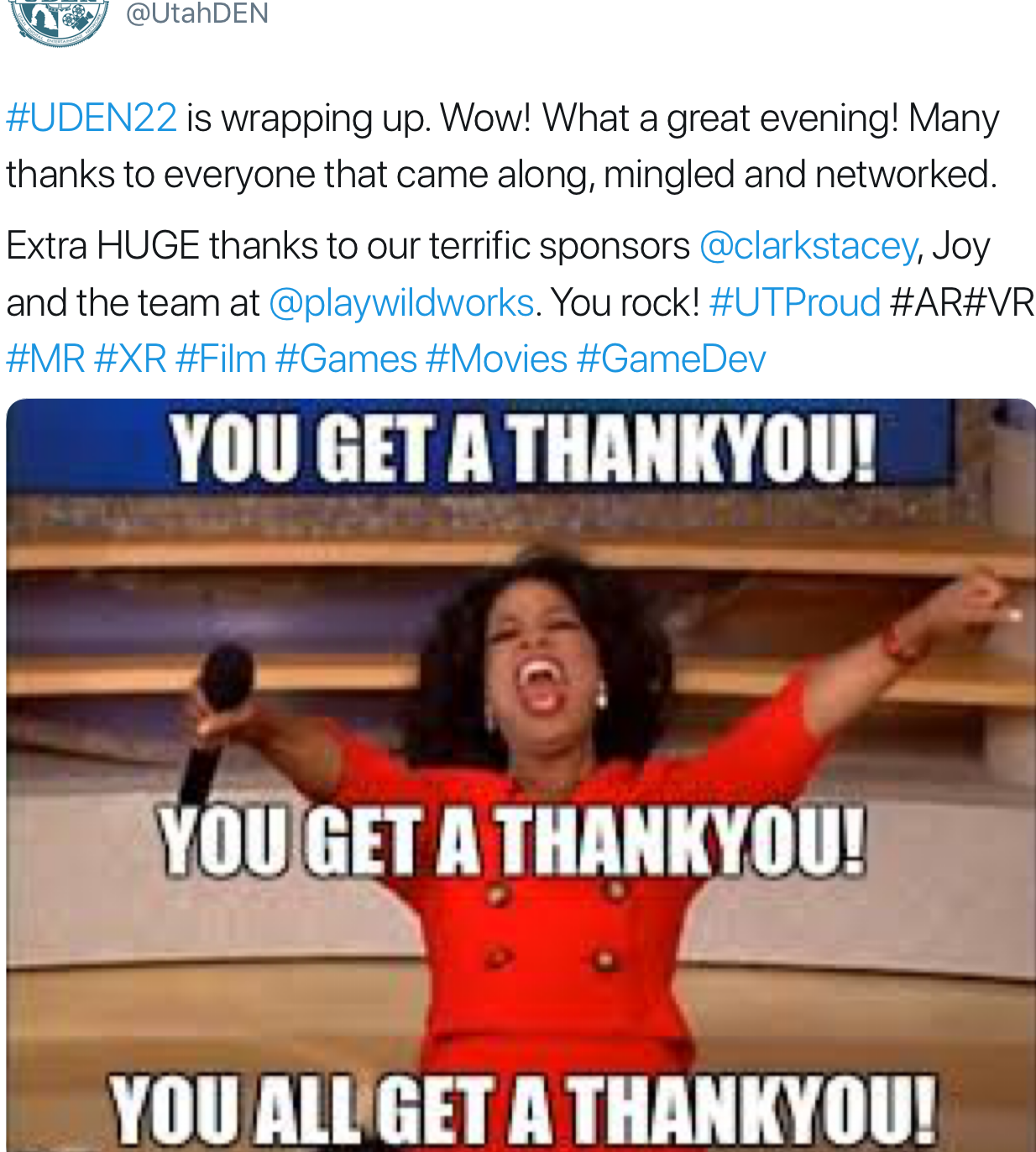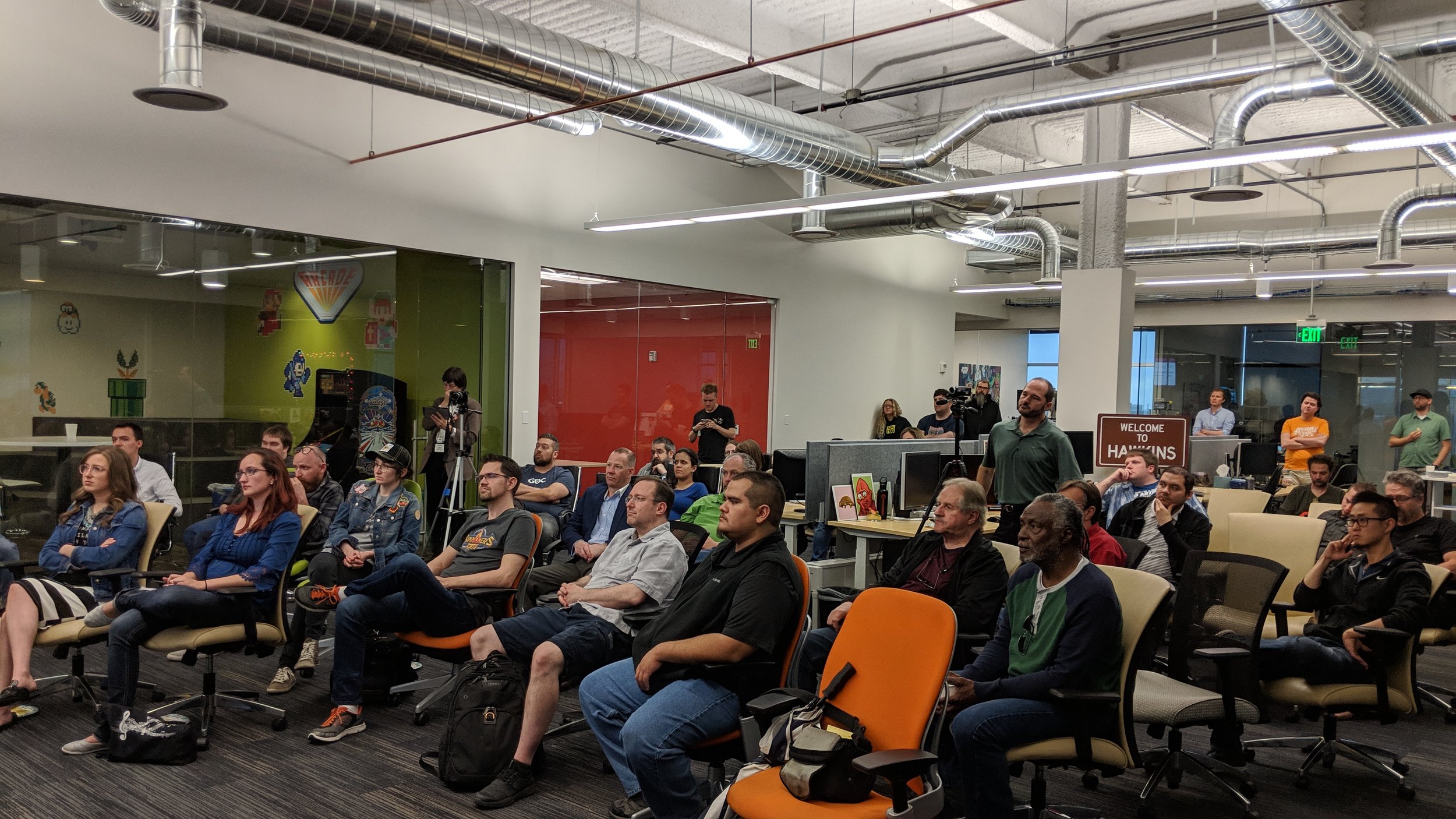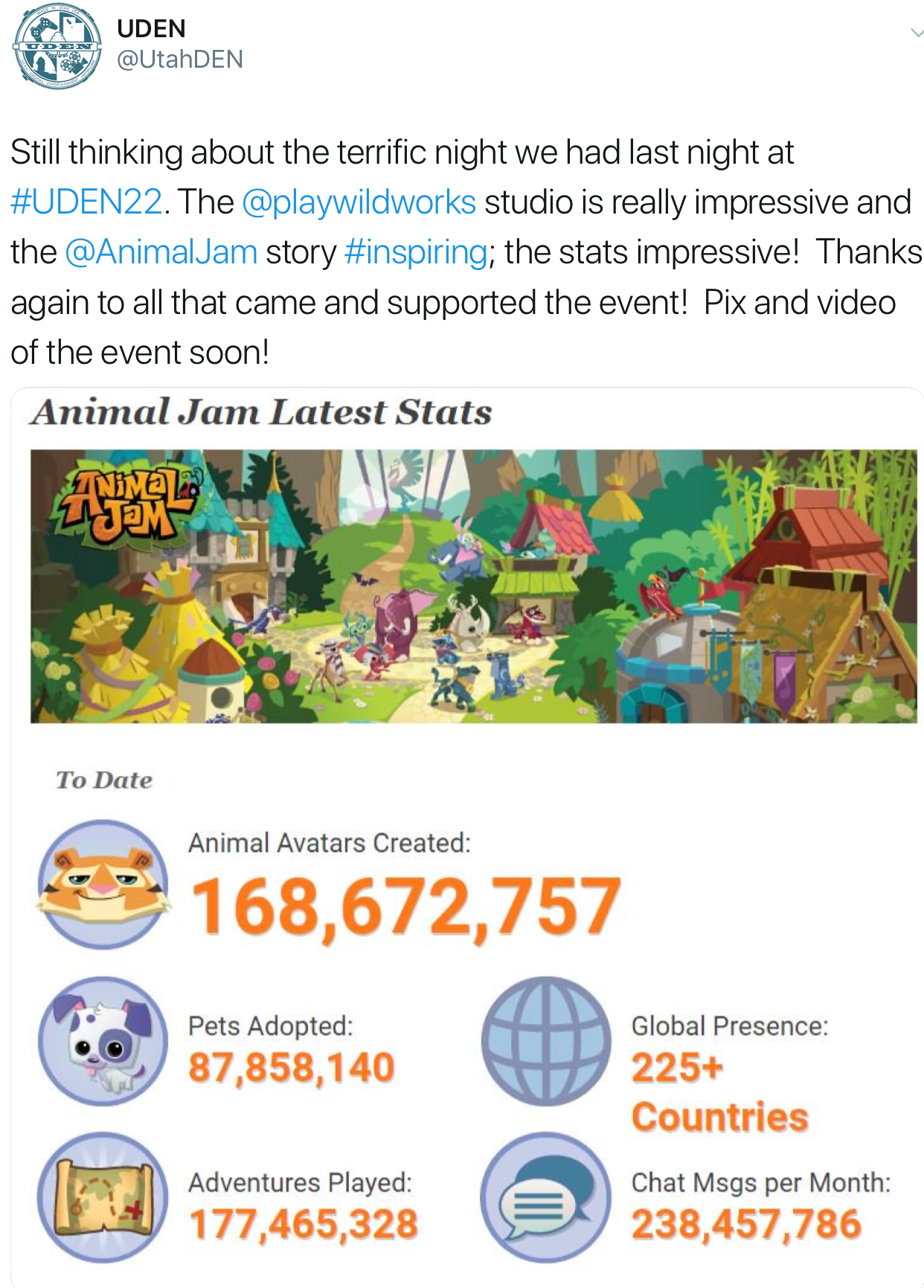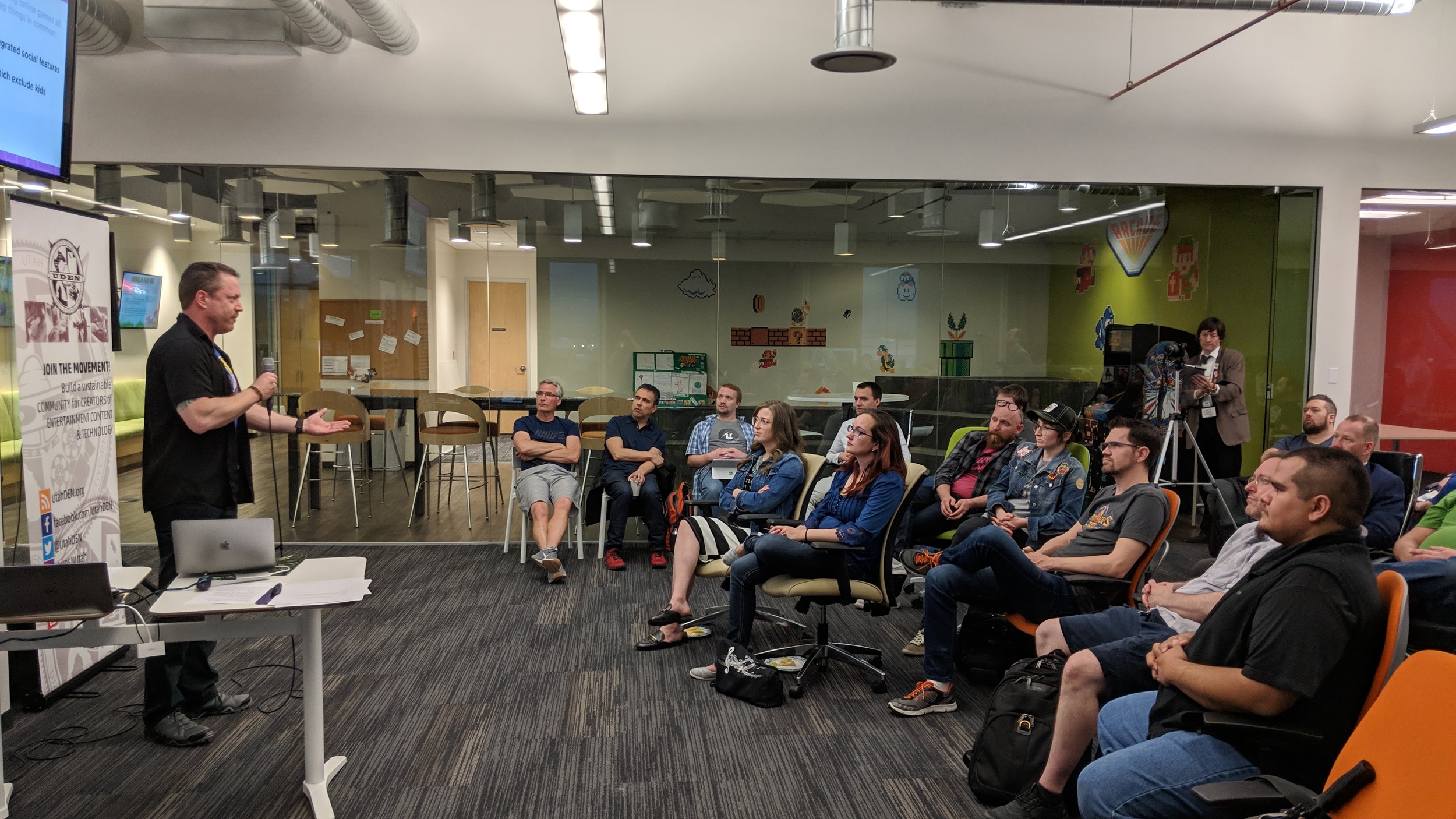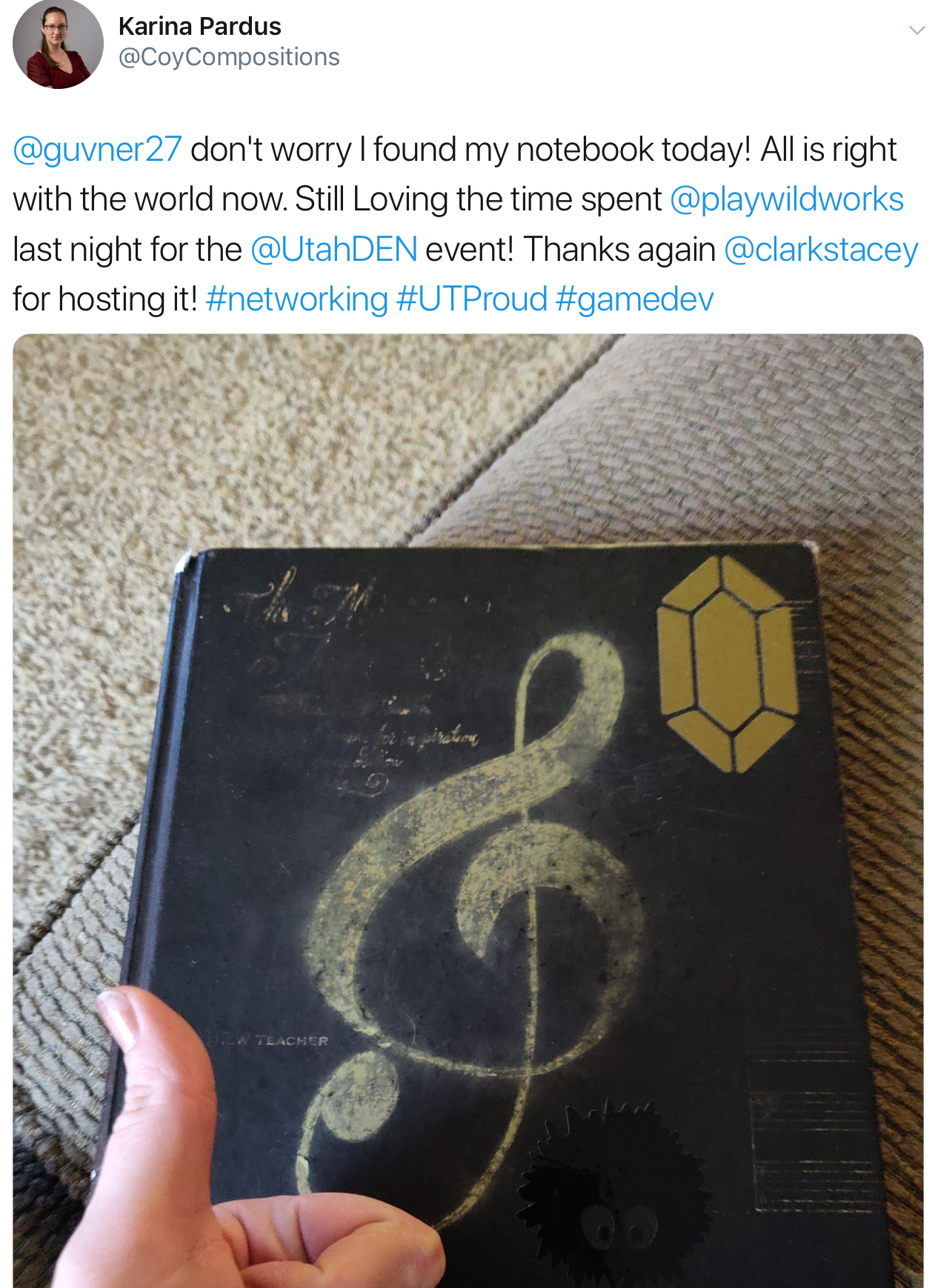I kicked the meeting off with an introduction and welcome to WildWorks, with an overview of what would be covered tonight. Here is a quick recap of how it went…
Let’s Get This Meeting Started!
For UDEN #22, we are super lucky to be invited to the videogame studio of WildWorks, a long-time sponsor and supporter of UDEN. Clark Stacey co-founded WildWorks 16 years ago with a commitment to bringing the production values of triple-A games to kids’ entertainment. The result is what WildWorks calls “fun with substance;” games that entertain children while nurturing their curiosity about science and the natural world.
Animal Jam is one of their creations; it was born and bred right here in Utah. The talented team at WildWorks took that ingenious idea from concept, through to household brand, becoming the most popular online playground for kids in the world with over 100 million registered users.
The mobile extension of this world, Animal Jam - Play Wild! has been among the top grossing iOS apps for Kids 9-11 since the beginning of 2016. It’s also received numerous awards, including the 2017 Google Play Award "Best App for Kids" and a Kidscreen Award in 2018 and again in 2019 for Best Kids App.
Best of all, Clark and the WildWorks team have made it look easy, but it hasn’t been.There is a lot we can learn from Clark, even if you’re not a videogame maker, even if you don’t make games for kids — and that’s why Clark will present the keynote at tonight’s UDEN meeting.
UDEN BENEFITS
In our April newsletter, we introduced a survey to find out how we’re doing and to talk about benefits and services. Our goal, as you may recall, is to build a community of the creators of digital entertainment and technology in Utah, leading to economic growth for our sector.
No doubt that’s a worthwhile and lofty goal, but what does that mean to you, today, and your needs, tomorrow? How is UDEN helping? Is UDEN providing any value to you? We’re always trying to think of practical things we can do that will help our community. Because we know that so many of you are contractors and self-employed, we had some ideas around providing some tangible benefits, such as health insurance and retirement plans.
But we wanted to know what you thought, and so we asked you all to complete a short survey. Tonight I’m going to share the results so far. I’ll be honest, I was a little disappointed in the results. Barely 1% of UDEN members replied. We could interpret this resounding lack of response as meaning UDEN is doing an outstanding job, after all, how could we possibly improve? Or it could mean that you forgot. Or perhaps you don’t read emails we send? It could mean you don’t care about getting any benefits. So, please help us help you, help us make UDEN an organization that delivers what is valuable to you, as well as helping to build our community.
I want to thank those people that did submit their feedback, and ask everyone else to please take the survey – there is a link on the website – please find a moment and complete it for us. It will take no more than 3 minutes, most of the responses are radio-style click buttons. It might take you 5 minutes if you want to add some comments.
So... Let’s see how 1% of you have responded to the survey so far…
Once again, many, many thanks everyone who did respond to the survey already, it is really helpful information, but we don’t have enough responses yet for this to provide us with a meaningful direction.
UDEN OVERSEAS
Last week Jeff and I were in Riyadh, which it transpires is even further south than Provo! It’s in Saudi Arabia, a country in the midst of cultural reforms. It’s only in the last year that they opened movie theaters – now there is a demand for movies with local themes from local film makers. Likewise, they would like to be able to make their own videogames; to tell their own stories.
Among the challenges they face, they don’t have local people skilled in entertainment; in the design, the creation or the business. We were talking to them about the potential of working with UDEN on our proposed apprenticeship program, which you have heard us talk about before. There is a lot of interest.
Jeff and I were fortunate to be invited to give some presentations while we were out there and we told the would-be entertainment creators about UDEN. We extended the hand of friendship on your behalf and offered to help them as they grow. Wouldn’t it be strange if our first UDEN chapter is in Riyadh! To start off they might show some of past UDEN meetings from our YouTube channel as there have been some excellent panels and keynotes. With the connection made, it’s possible that in future, they could be looking for collaborators. We are hopeful that could be UDEN members. It’s early days but we thought that was a pretty cool development!
Talking of pretty cool…
KEYNOTE - CLARK STACEY:
WildWorks History and Tips for Starting Your Own Game Company
Clark Stacey:
I might make it look easy because I don’t do a lot of the work, the talented WildWorks team here does all of that and they make it look easy for me, but I’d like to tell you a little bit about the company, the types of games we make and why we make it. Also I know there are some people here tonight that want to make games, or are making games, or starting companies, so I’ll share some advice about things to do or not to do based on mistakes that we’ve made. Then I'm going to show you something that nobody has seen before. I'm going to show you some of the new game that we're working on that will be launching later this year.
Blow stuff up games
WildWorks has been around for a while; we started in 2003. The other co-founders and I had a history of making “blow stuff up games” for a lot of years; AAA console stuff, a lot of vehicle combat; if it involved cars or planes blowing each other up that was kind of the stuff that we were doing. But when we started this company we saw a different opportunity… basically we observed that kids were really an under served demographic; the types of games that kids would get would be… a new animated film is coming out and somebody like THQ or Midway goes out and hires some yahoos like us and gives ‘em six months to put something in a box that they can throw on the shelf at Walmart that will at least boot up when you put it in your PlayStation. That's really about where the quality bar was. I think like a lot of startup studios, particularly then, you start out doing work-for-hire projects like that before you can build up enough speed on the wheel of karma that it throws you out into doing your own IP and that's the hope I think for everyone. That’s still very possible today.
For us that began with some projects with Namco Bandai, with Activision Value… we did a game on the Pac-Man IP called Pac-Man World Rally, we did some stuff with the Snoopy and Peanuts IP — we did what remains the best flight combat game on the Xbox platform with Snoopy Flying Ace. Then the bottom fell out of the market we were in. If you’ve paid much attention to the games market since about 2008 you’ll find there's not a lot of software on the shelves at Walmart anymore; there is certainly not a lot of kids software on the shelves there anymore because boxed software, kind of went away.
The pivot to original IP
The market for those type of quickie 6-month multi-sku projects based on the latest movie to come out, those don’t really happen anymore. In fact they don't often happen even with mobile games which are easier to distribute. That model was moved on with digital distribution, with the introduction of the iPhone… and it moved on because kids kind of moved on from that type of game and hopefully, they had their quality bar raised.
We saw that change and thought, hey, we’ve got some killer technology, we've got some super talented artists, designers and programmers, we could come in and actually do a lot better than the market currently had for kids right out of the gate. We came in that's what we did.
Some of the games that we went on to work on then, Animal Jam obviously being the the biggest one; Tunnel Town and some other IP that we've experimented with but along the way there were a lot of things that we did that never saw publication such as our lamented Barbie Guitar Hero game which I still really regret never came out… you never got to see it… you never got to see the awesome pink guitar that we had! The types of games that we were looking to publish, that we were looking to establish ourselves with, our theme was entertainment with substance. We wanted to make games that were not overtly educational because if you have kids or if you've ever been a kid, you know when somebody tells you that you're going to play an educational video game, that you know right away it's going to suck! With very few exceptions! Because they’re not very well made, because they’re made by educators or marketing companies or people who don't make games for a living.
Kids’ games not for kids!
We wanted to make something that was not overtly an educational game but had some educational DNA in it that was legitimate and that parents and kids could actually trust. We found kind of a unique niche that I'll tell you about. It came out of an observation that you can see right now in the App Store — if you look at the top top 200 grossing games in the App Store, they all have two things in common: deeply integrated social features, whether that's leaderboards or registering your Facebook account or they spread virally through your social media accounts. And they all exclude kids. At least they're supposed to. If they are a general audience game then they are supposed to not have these social features facing kids, or they have to obtain verified parental consent from parents to store the data and allow that interaction. So what happens is that most of them pretend that they're not for kids. What you see in the App Store now is a lot of games that are coming out that are obviously based on, for example, Frozen, for God’s sake! They’re based on what is obviously children's IP but they don't put them in the kids section of the App Store, they put them in the general section of the App Store and pretend they're not for kids… until now it has enabled them to get away with having a lot of the social functionality that helps these game spread virally without any of the regulations that would normally bound a game for kids. It’s starting to change dramatically and I'll talk about some of the reasons why.
We saw an opportunity and we continue to see a huge opportunity in what we do which is creating safe social games for kids; that is we have found through a combination of technology and elbow grease and a lot of attention paid daily to our audience, that you can have social features like chat, like buddy list and things that are carefully moderated for kids and you can enjoy the viral success that creates in your products… but also so you can do what is the most natural thing that happens on playgrounds everywhere: kids want to play with their friends… they want to meet friends… they want to make friends. When they have games that they play in the living room together, that’s the kind of thing that they do, the kind of thing that they're looking to do. We have enabled that with a technology platform that we've evolved over the years of operating Animal Jam called JamNet and that is what our future products are based on. It's something that we are beginning to offer on a license basis to other developers that want to make games for kids that have some of this social functionality.
Incredible engagement with kids
Animal Jam is as much a social network as it is a game. We have 110 million registered users, but that’s kind of a PR stat because it's a number that can only go up right? We get more registrations all the time. A stat that I like to highlight more is how engaged the players that are in there really are. During the school year, obviously, kids have a lot of things going on outside of Animal Jam but still their daily playtime is over 50 minutes. In summer that's 60 - 70 minutes. Kids aren't using this like Candy Crush that you play on the bus or something. They are using it as a social network. It’s how they keep in touch with friends who are out of town, it's how they keep in touch with their friends from school and they have a lot of friends that they meet and interact with just on Animal Jam. That's kind of what we wanted. To have this kind of engagement, if you compare us to, say, the Disney Channel or Nickelodeon or something, and you compare audience size, those would be great Nielsen ratings for a new show on the Disney Channel. But if you look at minutes spent and the amount of engagement there, Animal Jam is two or three times the engagement numbers of a Nickelodeon or Disney Channel. What are kids doing in Animal Jam for all that time? They're trading items — we have virtual items that your animals can wear or they can decorate their dens with — and the trading volume among kids exchanging those among themselves is roughly equivalent to the Australian stock exchange everyday; about 650,000 trades!
We have tens of thousands of new avatars coming in every day. We have tens of thousands every month of new art submissions kids are creating in our art tools, submitting to us, for us to moderate and approve and then they can put those up in their den, they can exchange them; they're playing the mini-games; there is a video platform on which they're watching a lot of educational video about animals in the natural world and sciences that we generate. So the engagement level is very deep. The educational part of it, I believe strongly that if the kids are interested in something thing then they will direct their attention and drive to learn about it as much about it as they can. Every kid has a favorite animal and they all want to know everything about it and they want to demonstrate to you their knowledge about it. There's no better advertisement for Animal Jam for us than a child who comes to the dinner table and says I just learned this about owls in Animal Jam. That parent is going to say “Okay, yeah we’ll pay to subscribe to Animal Jam, you’re obviously learning something”. The approach we take to education is that all the educational materials in the game are free, all of the core gameplay in the game is free: you can go in create an account right now and you can play Animal Jam for the next 10 years and never pay anything... you won't be excluded from social features or from playing different mini games and things. You won't have as many cool animals as members do and there might be some dens that you can’t see, but all the core stuff and especially all the educational stuff is free and open to you in an unlimited fashion.
We monetize Animal Jam and a lot of our other products through subscription. Particularly with kids we think that this is the most ethical, sustainable, understandable method of monetization. In-app purchase, which is much more common in the mobile realm, is very easy to abuse, particularly with kids that don't necessarily understand the the psychological tricks that can be used to induce repeat purchases. We don't want to create what is called in the in the mobile game space ‘whales’; we don't want kids racking up thousand dollar iTunes bills playing Animal Jam on a monthly basis. What we would much rather do is get a few dollars a month from their parents for a very long time and that is something that has worked out well for us because our subscriptions average over 14 months in length, so we're holding on to these subscribers for a long time because, I hope, they find value in it and the parents see that their children are actually getting something out of it beyond just a game that they're playing.
Tips for new start-ups: #1 Know the law
I tried to think of some things that I wish that I had known 16 years ago in starting this company, or 10 years before that starting the previous company. The first and primary one is that if you are getting into games now, you're an aspiring game maker, thinking of starting a studio and you are not familiar with COPPA and GDPR, these are the major things that are going to be governing the culture around games for the next decade. These are laws.
COPPA
COPPA, the Children's Online Privacy Protection Act has been in place in the US for almost 20 years and it basically governs how data can be collected and used, from users online on a website or a game app, that you know are under 13 years old… or that you should know are under 13 years old.
If you have a game that has animated characters in it that looks like a cartoon, that looks like something that ought to appeal to kids, by the letter of the law of COPPA you have to be compliant with these data protection policies. Which means that if you're collecting data from a child user, say to serve advertisements, to have the register an account, to save their about what they collected in your game, then you have to obtain verified parental consent in order to store and use that data.
If you don't the penalties are pretty severe — $16,000 per violation which means per user. Companies like Tik Tok that are shamelessly exploiting kids, harboring predators on their on their platform and collecting the kids data and selling it and using it, are getting some big fines. They’re not getting big enough fines to stop them but they're getting $4.5M - $5M fines. That’s pretty significant and for a small company that can be a killer. They can also ban you from publishing your game at all in the US anymore. There are some resources though: Privo actually I think has a really good primer on what you need to do to comply with COPPA and if you're thinking about launching a game, thinking about starting a studio, I would urge you to at least give this a scan and familiarize yourself with it and ask yourself is this is something that you have to comply with.
GDPR
GDPR is essentially the European Union’s equivalent of COPPA but ten times scarier because it opens the door to civil suits based on the same type of data privacy violations that COPPA deals with. That means that not only do you get a tremendous face kicking from the EU government but then all affected parties get to come in and sue you and take whatever's left. This is a company killer. There is also a GDPRK that is specific to kids. The difference between GDPR and COPPA is that with COPPA, if you are putting kids safety and privacy foremost in the design of your game and in the way that you do business then you’re probably going to be alright; you're probably naturally going to be doing the things that would help you comply with COPPA anyway. With GDPR you can have that as a primary focus of your business and you could still go awry. In the US, COPPA defines a child whose data has to be protected under this rubric as under 13. In the EU every country gets to define that age limit themselves: some are 15, some are 14 and depending where you're operating that's what you have to anticipate and adhere to. You have to store all of the data that users generate and be ready and willing to hand it over to them at a moment's notice. If a parent says “I want everything that you've ever collected about my child” you had better be able to zip it up and send it to them toot sweet. If you can’t, you can be in a lot of trouble, subject to a civil suit.
There haven't been any real headline-grabbing fines arising from GDPR yet but there haven't been a lot of these civil suits come to the courts yet either and I think that enforcement is being gradually on-boarded since it only started in 2018 and they're not really putting the screws on yet. But it's is coming and if you’re making games now and you're publishing them on the App Store or on Steam or anywhere else that is accessible worldwide you are subject to these laws and not knowing about them is not an excuse. Again, Privo can help you with that
Safe Harbor Programs
Something that is very valuable to us is a ‘Safe Harbor Program’ that offers some protection, with COPPA at least and hopefully there will be something similar coming for GDPR. A Safe Harbor Program basically means that there is a body of experts, in our case in organization called CARU, that reviews Animal Jam from top to bottom every year and makes sure that all of our privacy policies, our email practices, our data collection, everything is in conformity with best practice and COPPA law. Because of that if there's a violation or if there's a complaint, before the FCC comes and sues us and puts us out of business, or goes to the media and we have the worst PR day ever, they come to us privately and say you've got to fix this or we're going to come and stomp on you, and so you get a chance to fix it. That's basically what the Safe Harbor Program means, you get a warning before they come after you. It’s something you should absolutely look at if this is a part of the business and you're going to be in.
#2: Start with your team
Here are a few thoughts for those of you who are starting game studios or have started game studios: something I get asked all the time is “How do I get to get funding?” or “Who do I talk to for funding?” or “How do I get Angel funding?”. I want to make the point that funding is not the first concern, putting your team together is the first concern: identifying the core members of that team. You might say “Well if I don't have funding that doesn't matter because I can't pay the team”. Sure, but identifying the team, getting them to gel together should be your the first thing. I have a friend in Australia who has a two-person game studio — actually him and his cat — and then a couple of hours with remotely. A few years ago he came out with a not terribly original game based on an old arcade game, but it was a novel presentation of it, and it had a really cool, quirky art style. He threw it up on the App Store and a few days later suddenly he was making 50-grand a day and didn't really know why this had struck. This game has gone on to make many millions of dollars and launched his company. The reason that it worked was because the game was built around a solid gameplay mechanic, plus he had found an artist that took a quirky take on these characters that nobody had really seen before, that was just a lot of fun to look at and play with. That artist was somebody on something like deviantART or one of these remote working sites. But because he had identified what he needed team-wise first, before worrying about funding or anything, he was able to create a hit out of nothing.
#3: Start with games your team can actually make!
User acquisition is the other big concern most people have in starting game studios and it's a legitimate concern. But my observation has been… and any of you are welcome to prove me wrong… that really great Innovative products that are executed really well don't die on the vine. There are plenty of innovative game mechanics and game ideas that have a boring art style or a mediocre UX execution and those probably go nowhere. There a lot of highly polished copycat games that are just another Match-3 with super polished and beautiful user interface, but they don’t go anywhere either. If you have the innovation and you have the execution then user acquisition is not going to be your number one problem; there are still going to be challenges there but UA is not going to be the number one.
Start with games that the team you've assembled can actually make. Related to this is the first gig that you do doesn't have to be your magnum opus that you've long dreamt of making; the fantasy RPG that's going to take a hundred million dollars to complete and launch is probably not the first thing that you and your buddies working out of your garage ought to take on. Don't be fooled by the success stories that you hear of people who look like they just came out of nowhere and that's exactly what they did. None of those real in the sense that they might look. Think about about Steven Spielberg: his first gig was doing bad TV shows that you've never heard of. Pixar didn't even get to make real animated film for their first five or six years! They found they had no market for it, they had to build physical computers and sell those to stay in business while they tried to figure out this whole computer generated graphic arts thing. The example that a lot of people love to cite in games is Notch, the creator of Minecraft. But he worked for King.com, the most derivative game company there is, for many years before he ever got to go and do Minecraft. So it doesn't come from nowhere, your first game is not going to be your only shot; work your way up to that magnum opus — wait until you can self-fund it; wait until you don't have to make any creative cuts based on the funding in order to realize that vision. There's a lot that you can do in the interim, there are a lot of people out there looking for talented small teams to come in and do parts of their game or to work on adjacent type of products.
#4: Find under-served audiences
Something that we have been very fortunate in and show you kind of how this plays out, is identifying gamers, or audiences, that really aren't being served by what's out on the market now. There are still plenty of these demographics out there now that want to play games, that are playing games but that really don't don't push their buttons that much; maybe the game mechanic is one they like but they're not really into the whole, maybe, real time strategy war-thing, maybe they wish it was something different, a different look… there are so many opportunities out there for this now. We were fortunate with Animal Jam in identifying that pretty much everybody who thinks of kids games is thinking of preschool. Yet there's this whole swath of audience between 7 and 13 years old that nobody is making games for. If you go look at the kids category of the App Store right now, there is nothing in there for kids that are 8 and over. The games might state that they’re for 8 or 9 and older, but really it's not, they’re preschool toys.
We found a niche, an underserved demographic in these kids that really wanted a safe playground online to meet with their friends or meet new friends; a non-toxic community they could join for kids who love animals and dig art and love doing the kind of activities they can do an Animal Jam. There are a lot more opportunities like that out there; if it's not an underserved demographic it could also be an under-represented fantasy. When we think about what kind of game do we want to build next, we often think about what is the core fantasy behind that game: is it ‘I'm a Space Marine, I'm going through and killing everybody on this Moonbase’?, ‘I’m an Italian plumber who's going to rescue a princess’? What is the core fantasy that the player is going to become and be? What is the player’s primal urge that is going to be satisfied? There is a zillion of those out there right now that are are totally untapped in games. Is anybody here familiar with Playrix and their games like GardenScapes? This is a company that took match-3 Candy Crush type game play and they took Farmville type game play and they matched them together and they found this huge audience of people who'd that's exactly what they wanted to do… they like the match-3 gameplay and they wanted a story behind it, you know, a narrative to take them through it. Those games must be making a hundred million dollars a year plus. There are so many opportunities out there still that are under-represented.
The message I would have for you is that there were a lot of these audiences that are not being served by the stuff that's in the App Store right now which is mostly real time strategy, which is Game of War, is Match 3. I mean it it all starts to look the same after a while because it's all going for the largest common denominator. There is a lot of open water like this out there and if you can take a step back from the marketplace and look at it you can find it.
What’s next for WildWorks?
Our core demographic for Animal Jam is around 8 - 13, then we have this huge spike of kids 16+ who are very active members of the Animal Jam community playing the game. What are they doing in there? They have been there since we launched the game in 2010. They have stuck around that long because there's nothing else for them to graduate into. The only social network type thing for them to go into is something like Instagram or Snapchat which is totally toxic especially to girls, or core game communities like Roblox or Minecraft, totally toxic especially for girls. There aren't very many game communities, none at the scale of Animal Jam which is what they’re looking for — fantasy role-play avatar based social gameplay but geared towards them. Because we have this audience and because they are so engaged, we can talk to them, and what they're asking us all the time is can you make something like this but for older kids. Something that still has the filter, still has protections, still a walled garden but the walls are a little lower. Maybe I can exchange YouTube links with my friends, I can show off my my Instagram page, I can do things that I can't do an Animal Jam and I can do it in an environment that is aged up from Animal Jam.
So we looked at what the core fantasy of Animal Jam, which is kids become their favorite animals, they see the world through their eyes. Then we looked at how kids were the drawing and representing their animal avatars on Instagram or on YouTube or deviantART or places like this this and it looked a lot more mythological, it looked like the Chimera of human-animal hybrid, or these super fanciful versions of combined animals… it was a really unique look in and of itself. We took that as a starting point and said well what if we did something but with mythological animals; instead of it just being all of them together in one spot, it was a reality show. So, we are launching at the end of this year Feral, which is a reality show for mythological animals, where kids will be designing their own animal creation and they will be competing against one another for the favor of the internet audience and for the queens that ruled the realm that they're in. It is exactly what this audience has been asking for and that nobody has delivered.
In Feral the player designs their avatar from the ground up; we started completely over completely over in the character creation interface for this game and we start with some some some mythological basis, such as Kitsune, a mythological Fox. We start with that as kind of the the seed, kids take it from there and they can create something of their own; colors, tattoos, size, appendages, it is a very robust character creator that is going to give every kid in this game the ability to give their avatar a completely unique look. Then we put them in a world that has a narrative drive behind it and a social core — there is still the principal of ‘I'm meeting up with my friends in common hubs where we’re exchanging items’ but it's aged up a little bit from Animal Jam… we’re not just giving you the items you're going to trade with your friends, we're giving you the opportunity to go out into this world to find stuff and craft with it, and make those items, design those items yourself and trade those with friends. We're giving players the opportunity to do some crazy offbeat quests and things you'll be assigned. like you might be in a reality show, and we’re also tying in social favor come from the way that you integrate. Maybe the best way to offer an example of this is, early on in Animal Jam we saw the kids were creating music videos in the Animal Jam world. They were going out, gathering a bunch of their friends and staging these elaborate dance numbers inside Animal Jam set to the music and then putting them up on YouTube and they were awesome! They were really, really cool! With Feral we want to design something that from the beginning gives you the opportunity and the encouragement to make stuff in there, making stuff with your character, make stuff with your friends, whether it's video, it’s images it's artwork that you exchange in there and we tie it into your social networks outside of here. If you want to create a Feral themed Instagram page, you can do that on Instagram, turn the comments off and route them instead through here where you have some some bullying protection, you have some chat filtering, you have a safer place that parents and kids can trust. We look at it as an interim step between the completely walled garden of Animal Jam and the completely Babylon of a YouTube comments thread, which is not something that any 13 year old needs to be dropped into unprepared. This is a place where we can hopefully encourage some better net citizenship by having some guardrails on the interaction as they step from one realm to the next. Feral will be in a friends and family beta end of the Summer, early Fall. You will have an opportunity to sign up and test at fer.al. And it will launch by the end of this year; that is, anyone will be able to go in and create an account and start playing. It will be an experience across desktop computers and mobile so both can play with one another and we think Feral to be the evolution from Animal Jam, extending our demographic older. Our next steps after that will be extending our demographic younger and then growing them both.
Q&A
Per your comments about GDPR, does a member of your team need to be a lawyer?
Per GDPR, you need to have a Chief Privacy Officer designated in your company. That person doesn't have to be a lawyer but they they do have to sound like one if the EU calls up and ask them questions about how you handle data security.
You mentioned a third-party you can work with for compliance. Does this apply to any size team?
I would look first at the at the guidelines that are on the Privo website; if it seems like something could go wrong with your implementation then consider the security of a Safe Harbor Program. Privo lists the different Safe Harbor providers, companies that the FTC has designated are authorized to go in and review products or websites or whatever and certify them as being COPPA compliant, and if they're certified as COPPA compliant then that's when you will get the phone call from the FTC before you get the phone call from the New York Times. That’s a huge advantage. Those organizations do charge based on your audience in some cases, in other cases it's a flat fee, but also really your need for that scales with how much social interaction you offer with your game anyway. But if your game is not overtly aimed at kids then maybe don't have to worry about it. GDPR there is no Safe Harbor yet; I know of a few organizations that are lobbying for that and trying to get it done.
With live service games like Animal Jam and now Feral, how do you handle ‘crunch’ and take care of your teams?
The short answer is that early on we didn't do a very good job of that; Animal Jam is going on it's 9th year now, our content pipelines have gotten a lot better and we have kind of learned to pace ourselves to create updates on a schedule that our team can do. We have some support resources, outside studios that can contribute to some of the artwork stuff that we don't need to do internally but I think this is a very important point. I would hope that you could ask anybody from WildWorks here when was the last time they had to crunch. It does happen though, especially on new products like Feral where we're trying to hit milestones and get to a certain point but on established products like Animal Jam or some of our other live-ops games we don't kill our team in order to feed that content monster. These games are updated every couple of weeks and from the outside it looks like a pretty blistering pace but there's some things you can do particularly on mobile — when we update the app on mobile we can have some content that releases when the update comes out and we can have some in the update that is timed for later, to continue release week after week until the next update comes out. so we've already built it, it's already in there, it's already tested but we can release it gradually from the app. There things like that that we can do to pace that content out, but really it comes down to the processes that our artists have built, the tools that our engineers have built which are fantastic and that's what it enables that.
What advice would you give to those of us starting out to prevent crunch at the beginning of our projects?
If your project is going to require those kind of live updates then what I would do is make sure that while you're still in development you have designated somebody on your team was going to be a community manager, that is somebody who is going to take the lead in communicating with the community and helping to set their expectations for what the content updates are going to be, because you don't want to promise and not deliver or under-deliver. Unlike in the hardcore game, [WildWorks] is lucky because kids are much more pleasant audience to work for than the average, for example, OverWatch player, but even even there it's incumbent on us to set their expectations accurately and if we say we're going to do something on a certain timeline then to do it and if not then to tell them no, we can't do that on that time line and then here's why. Generally if you signal that, they [your community ] come to understand that there's integrity there, you're as good as your word and they will cut you a lot of slack. But if you're making the promise that ‘hey we’re gonna update every week and it's going to be awesome and all this new stuff is going to be coming out’… and then you don't, that's where you get into trouble.
How do you help your Feral team with the crunch you describe?
This team has had to take on a Herculean task, because without growing the the internal team here we have added on a whole other live-ops game of the scale of Animal Jam on to their shoulders. The only way that we can do that is by offloading some of the Animal Jam on mobile and Play Wild! on web, to outside studios that can carry some of that load. For instance, we have so much data having done this game for so long we know what type of features what type of content are most desired most exciting thing for kids playing Animal Jam; if that's a certain type of animal avatar or new pets or new dens or or whatever… that's all content that we built a million times now and that pathway to getting it into the games is pretty well trod… that's the kind of thing where we can do the core design work here and then we can oversee and outside studio doing it and that frees up a lot of cycles here to work on the new stuff… which these guys will probably tell you they want to be working on anyway, cuz it's a hard gig, even if you love Animal Jam, to work on it for 9 years, that would be a tough lift.
What are the lessons film makers are not getting from the game world?
Maybe the obvious answer is like what Netflix is doing now with Black Mirror and offering interactive choices within a narrative framework that people are used to… but I think you're also seeing it more in the background of what Netflix and Amazon and those guys do because Netflix knows more about its audience than Sony Pictures or Warner Brothers or those guys ever did. Netflix knows things about their audience that their audience doesn’t know about itself, in terms of what they're real preferences are… not just “I want to see more cartoons” or “I want to see more rom-coms”, but what types of storylines they respond to, what types of Storytelling tropes they respond to. We have the advantage of having this real-time ongoing conversation with out audience that most filmmakers don't and we do that by having a lot of feedback mechanisms in the game, by having a very hands-on community team that's listening to our users all the time and constantly feeling their pulse… and we have a lot of data that the game generates that tells us a lot about what they like and don't like to. I think if there's if there's anything that's that's an easy pick up for film makers it's probably not something that you're seeing overtly now in what Netflix does, but I can guarantee they're doing a lot of it and they're investing a lot, because they're spending billions of dollars a year now on new content and they're not doing the old studio model of throwing a dart at the board to see what they make, they have a much better idea of what's going to work and what isn't.
How has working on a toy-line worked out for WildWorks?
We launched an Animal Jam toy line in Target and Walmart in 2015-16; we have had about 55 licensees on and off. The toys did extremely well in their first year and sold millions of units. I think that are toy partner Jazzwares dialled them in a little young for our audience, going after the Shopkins market when really our audience is more toy collectors than toys playsets type of players… but we've been through that boom and bust cycle with toys and with a lot of other products and we still have them, we have a subscription boxes that include toys that are still doing quite well and apparel. .There's a lot of lessons to take but for a game studio maybe the ones that are not the most obvious is that the production cycles on different types of products are way, way off what we've learned to expect as digital creators, where we can turn on a dime with new ideas and new products… depending on what it is that you're making , once you're committed to molds then you're stuck with those for a while at least until you get return on investment for those. If you decide you want to make pajamas you have a regulatory approval period that is nuts… to have your pajamas tested and certified that a child can wear them and not burst into flames in the middle of the night… there are things like that you probably don't know just intuitively about the product cycles and how long it takes to develop, how far in advance you need stuff to them, when those drop-dead dates are. For us it's come down to having really good comprehensive style guides and good processes in place for approvals and for feedback. It’s quite different.
How important are toys to the Animal Jam brand now?
Even when our toys were selling millions of units it was not a huge revenue driver for us, it’s more of a brand marketing exercise and we made it a principle when we started our licensing program, that everything we made, whether that was lunch boxes or books or pajamas or whatever, would have a game code with it that would unlock something in the game and ideally something that you couldn't get any other way. That didn't go over well with Apple so we backed off from that a little bit… but that's what it was for us and when we were studying this, we talked to other game companies that has done this kind of toy redemption thing, and they were telling us you'll be really excited if you get 3 to 5% of your toy purchasers actually redeeming their codes in your game. We got 22%. Because that was really the focus as much for us as revenue. We wanted an experience that extended what you were doing in the game. I think that's more important to us, giving our audience what they want than it is as a primary revenue driver. Toy royalties, consumer product royalties, unless you're Disney, you're talking about 10 to 14% off of net, you have to sell a lot to really move the needle.
Can you explain your partnership with National Geographic?
When we looked to focus on our own IP and launch Animal Jam, we were going up against Disney, Viacom and people who have their own cable channels, so how could we get brand recognition? How could we compete when they can advertise their stuff on TV all they want? So we looked for an already-established kids brand with some of the same mojo that we tried to inculcate in Animal Jam with the idea of affiliating with them. We looked around, we talked to a lot, we got fairly far down the path with Animal Planet but we really liked the Nat Geo guys. What we did was actually pretty straightforward licensing deal with them; they they did not have any editorial control over Animal Jam, they didn't own any part of it, we just went out and licensed their name and their yellow rectangle and put it on the game, in such a way that when we launched it looked like National Geographic Animal Jam. I think that probably got us our first quarter million registrations or so, they came straight from the Nat Geo Kids website, but by the end of the first year we were sending them more traffic than they were sending us and by the end of the second year Animal Jam was orders of magnitude bigger than Nat Geo Kids. It was definitely a good deal for them, such a good deal that in fact we cut it off about a year and a half ago, Animal Jam was rocking without National Geographic and we hadn't been using their brand really for a for a long time. But it enabled us to work with a lot of other educational partners too.
What’s your hope for the future of digital entertainment in Utah?
I don't want WildWorks to be the biggest studio, as it is now; I don’t want us to be one of the three biggest studios here; I want to see a lot of studios in this valley and I want to see a healthy ecosystem here, which might sound counter-intuitive — don't you want the talent pool all to yourself? — no, I would rather have an ecosystem here that attracts a lot of talent from different places, attracts investment from different places, so that when I talk to a superstar engineer who's been in Silicon Valley their whole career and come to realize they're never going to own a house and is thinking about maybe the Salt Lake Valley would be good to move to…. but if I move there and things don't work where do I go? Adobe? I go down the MLM Corridor here and sell Noni Juice? I want there to be a vibrant digital entertainment ecosystem here so that investors are looking at us and talent is looking at us and we've got it at a net inflow. I would like to see a lot more companies big and small.
Many thanks to Clark, Joy and the entire team at WildWorks for being such great hosts, for sponsoring this event and for such a great insight into one of Utah’s best videogame studios!

